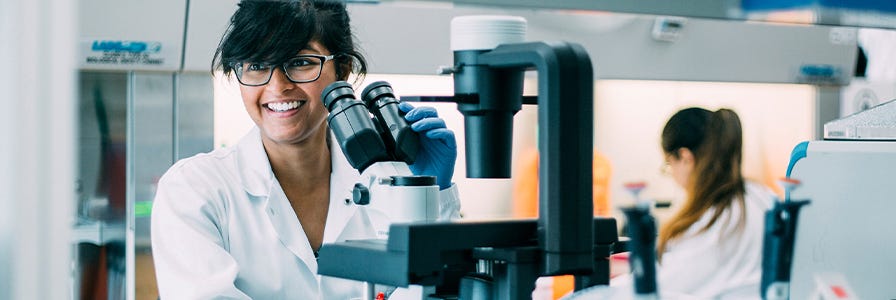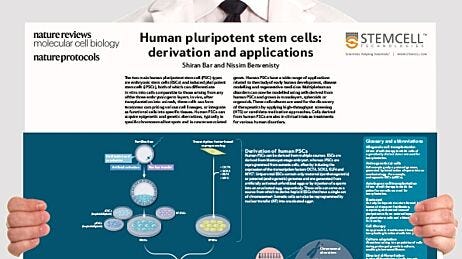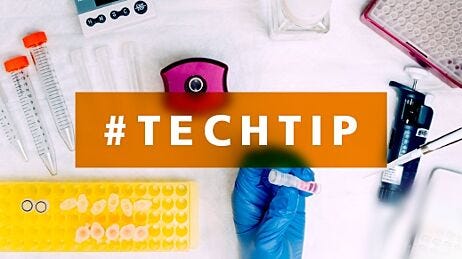A Year in Review: Our Favorite Science of 2022
CAR T Cells, Exosomes and Cancer Research, Protein Folding, Organoids, Single Cell Analyses and More

Dear Scientists and Colleagues,
I am delighted to share that we are continuing our STEMCELL tradition of summarizing some research discoveries that inspired and delighted some of our scientists throughout the year.
This year, I was particularly impressed by the multidisciplinary nature of the research our scientists selected. It’s truly inspiring to see various fields of research come together synergistically to advance knowledge and discovery. In the immunology field, in addition to deeper learnings about SARS-CoV-2, we saw some incredibly exciting and promising discoveries in immunotherapies, including those for solid tumors. Of course, organoids continued to serve as valuable tools for drug discovery, disease modeling, and toxicity testing, with some very exciting studies and discoveries, including successful transplantation and function of brain cells. Other topics that caught our interest include advances in the ability to culture stem cells, including totipotent stem cells and porcine muscle cells for cultured meat! We also share some exciting bioinformatics and bioengineering research on protein folding for the purposes of biotherapeutic development. I hope you enjoy our scientists’ selections from 2022 as much as I did.
Wishing you all the best in health, happiness and scientific discovery in 2023.
Sincerely,
Dr. Sharon Louis - Vice President, Research and Development
Science Selected by Our Scientists

Dr. Grace Poon's Favorite Science of 2022
Senior Scientist
Immunology
CAR T Cells Produced In Vivo to Treat Cardiac Injury
Chimeric antigen receptor (CAR) T-cell therapy typically involves the isolation of T cells from blood, which are modified to express a CAR that targets tumor-associated antigen, and then infused into the patient to fight cancer. As a way to treat cardiac fibrosis, Rurik JG et al. from the University of Pennsylvania successfully generated CAR T cells inside mice by delivering CD5-decorated lipid nanoparticles carrying mRNA encoding CAR that targets pathological fibroblasts. The CD5 allowed targeted delivery of mRNA to T cells, while the natural instability of mRNA led to transient generation of CAR T cells in vivo, providing specificity and control, which is truly inspiring.
Immunological Conversion of Solid Tumours Using a Bispecific Nanobioconjugate for Cancer Immunotherapy
Solid tumors do not respond to immunotherapies as well as blood cancer, in part because cancer cells are well protected by the suppressive tumor environment. A team of researchers at MD Anderson Cancer Center, co-led by Wen Jiang and Betty Kim, developed a nanotechnology platform that can decorate solid tumor cells with an “eat me” signal, thereby activating intratumoral immune response, making them more receptive to immunotherapy. This immune conversion technology can be adapted to different tumor markers or immune molecules, providing broad application potential. This could be the missing piece that enables existing immunotherapy to be effective across solid tumors!
Maturation and Circuit Integration of Transplanted Human Cortical Organoids
Human brain organoids were transplanted into immunocompromised newborn rats where robust integration and maturation was observed over 90 days, and more importantly, a behavior impact was established. One of the novelties of this work was the transplantation into newborn rats instead of adult rats, where the brain is less established. This likely favored the development of the human graft, which grew up to nine times in size. This sophisticated work was delivered by Raveh et al. from Stanford University, and provides a powerful tool to study complex brain development or disease where connectivity between neurons and the body is essential.

Samantha Darling’s Favorite Science of 2022
Research Associate
Pluripotent Stem Cells
Induction of Mouse Totipotent Stem Cells by a Defined Chemical Cocktail
In mice, totipotent stem cells (TotiSCs)have only been identified in the zygotes and blastomeres of 2-cell embryos. With the ability to differentiate into both embryonic and extraembryonic tissues, they are the only cells capable of forming an entire organism. Here, TotiSCs were established from mouse pluripotent stem cells via chemical induction utilizing three small molecules (TTNPB, Azakenpaullone, and WS6) and were maintained long term. At transcriptome, epigenome, and metabolome levels, these cells resembled 2C-embryo stage cells and exhibited bidirectional developmental potentials in vitro and in teratoma. This work gives us a foundation to understand and study the totipotent state.
Exosomes: Small Vesicles with Big Roles in Cancer, Vaccine Development, and Therapeutics
Exosomes are extracellular vesicles (EVs) secreted by various cell types, including cancer cells, and are present in biofluids. After the emergence of multiple studies, EVs that were previously considered “rubbish bins” for cells are now considered crucial for intercellular communication, carrying a number of components, including proteins, lipids, and genetic material. This review outlines their involvement in malignant cancer development, through autocrine, paracrine, and endocrine communications within the tumor microenvironment, by facilitating communication with neighboring cells. Additionally, it covers how EVs can be utilized in immunotherapy and vaccine development due to their potential ability to carry and deliver cargo.
Production of Cultured Meat from Pig Muscle Stem Cells
Cultured or “clean” meat is a rapidly emerging industry, poised to be a sustainable alternative to animal farming due to its reduced impact on the environment and more favorable ethics. However, scientists have struggled for years to achieve scalable protein production because of a number of challenges, including harvesting, expansion, differentiation, and structuring. This paper outlines the use of harvested porcine muscle stem cells, cultured in a media supplemented with L-Ascorbic acid 2-phosphate (Asc-2P), to preserve stemness and muscle cell differentiation capacity. The product closely mimics pork meat, and the paper presents a realistic workflow for the production of cultured meat.
On-Demand Human Intestinal Organoid Course
Learn from our in-house organoid experts as they demonstrate how to culture human intestinal organoids and apply them for functional applications in your research.
How to Tri-Culture hPSC-Derived Neurons, Astrocytes, and Microglia
Model neuronal-glial interactions and neuroinflammation with this optimized human pluripotent stem cell (hPSC)-derived 2D co-culture protocol, incorporating the highest quality at every step.
Networking and Conference ToolKit
Browse our collection of downloadable tools to prepare for a networking event, including best practices for your LinkedIn profile and your elevator pitch.
10 Tips for Attending Scientific Conferences
Plan ahead and be prepared for the next conference you attend by reading these tips and downloading the toolkit ahead of time.

Dr. Charlie Stevens’ Favorite Science of 2022
Senior Scientist
Bioinformatics
Current Structure Predictors Are Not Learning the Physics of Protein Folding
DeepMind AlphaFold technology has decisively demonstrated the power of machine learning (ML) methods in biological science. This paper from the Oxford protein informatics group articulates one of the next key challenges in structural bioinformatics: the development of computational tools that can predict and modify protein folding kinetics. Harnessing the physics of folding will enable researchers to create completely novel designs for functions such as molecular detection or conditional activation. This paper demonstrates that, while the value of fast and accurate protein structure prediction cannot be understated, there is still much to do before the protein folding problem is definitively solved.
Hallucinating Symmetric Protein Assemblies
Creating novel sequences that fold into proteins with desired properties represents a monumental step in protein design. The Baker lab from the University of Washington has published a method to generate de novo sequences that form symmetric protein multimers. Given only the desired length of each monomer and the desired oligomer size, this method will return a number of possible designs that serve as scaffolds for functional molecules. The sequences produced very diverse folds, and after expression, the experimentally derived structures matched the predicted structures with unprecedented accuracy. Development in this area will redefine the future of biotherapeutics and nanomachine development.
Enhanced Safety and Efficacy of Protease-Regulated CAR-T Cell Receptors
Chimeric antigen receptor (CAR) T cells have been revolutionary in the treatment of cancers, and this paper describes an ingenious mechanism to control their activity. The signal neutralization by an inhibitable protease (SNIP) CARs pair the receptor with an inhibited protease such that the CAR T cells are only active when the inhibitor is provided to a patient. This, effectively, causes the CAR T cells to be in the off state by default, which allows for the use of higher potency CARs, increasing the therapeutic window of the treatment. This engineered, regulable therapeutic looks to be superior to existing constitutive CAR T cells or those with a self-destruct failsafe mechanism built in.

Riya Sharma’s Favorite Science of 2022
Scientist
Research & Development
En Masse Organoid Phenotyping Informs Metabolic-Associated Genetic Susceptibility to NASH
Nonalcoholic steatohepatitis (NASH) is a prevalent inflammatory liver condition, and its symptoms are often invisible until the damage is beyond repair. Understanding risk factors and genetic markers of the condition are critical for treatment, and there are several ongoing efforts to establish a truly physiologically relevant in vitro liver microtissue for modeling and therapeutic screening applications. In this publication, the Takebe Lab performed high-throughput phenotypic analyses using pooled donor samples of their pluripotent stem cell (PSC)-derived steatohepatitis organoids to identify the impact of NASH-relevant genetic factors under diabetic and non-diabetic states. This work demonstrates promising applications for organoids in the development of treatment strategies.
Human Branching Cholangiocyte Organoids Recapitulate Functional Bile Duct Formation
Several organoid models across cell and tissue types often exhibit a spherical, cystic morphology that does not align with the architecture of the native tissue. Since spatial cues can play a critical role in cell patterning and maturation, these differences may contribute to organoid models failing to fully recapitulate in vivo cell identity and function. In this publication, the van der Laan group describes culture conditions to generate complex branching human cholangiocyte organoids that resemble in vivo intrahepatic bile duct structures. These culture conditions can also be used to generate cholangiocarcinoma tumor organoids that better model primary tumors, including chemoresistance to certain compounds.
FXR Inhibition May Protect from SARS-CoV-2 Infection by Reducing ACE2
The farnesoid X receptor (FXR), a member of the nuclear receptor superfamily, modulates bile acid, lipid, and glucose metabolism in the liver. In this publication, the Vallier and Sampaziotis labs characterized the role of FXR in the regulation of ACE2 expression in multiple COVID-19-affected tissues, presenting a novel therapeutic target for SARS-CoV-2 treatment. FXR antagonists Z-guggulsterone (ZGG) and ursodeoxycholic acid (UDCA) downregulated ACE2 expression in human lung, cholangiocyte, and intestinal organoids. UDCA-mediated ACE2 downregulation was also demonstrated to reduce susceptibility to SARS-CoV-2 infection in vitro, in vivo (mouse and hamster models), and in human lungs and livers perfused ex situ.
Webinar: From Academia to Industry – Taking iPSC-Derived Muscle Cells to the Clinic
How will you navigate the translation of your gene or cell therapy research into the clinical space? Learn from the experience of Dr. Peter Andersen, who discusses how he took his translational research on iPSC-derived muscle progenitors from academia to industry.
New Wallchart: Frequencies of Human Cell Types in Blood-Related Sources
Get a free copy of this wallchart summarizing the frequencies of more than 35 cell types in blood-related sources. Hang in your lab as a handy reference on the cells you’re working with!

Dr. Ehsan Samiei’s Favorite Science of 2022
Senior Scientist
Research & Development
Matrix Viscoelasticity Controls Spatiotemporal Tissue Organization
Mechanical cues from the extracellular matrix (ECM) play a crucial role in regulating the cellular phenotype and cell and tissue dynamics. The authors of this paper show the role of the matrix’s viscoelastic properties on regulating proliferation and spatiotemporal organization of breast cancer and non-cancer tissues. By modulating the polymer molecular weight and crosslinker concentration, elastic and viscoelastic matrices were developed with similar stiffness. While elastic matrices form symmetric spheroids, the authors show that viscoelastic matrices induce symmetry breaking and protrusion of finger-like structures from the tumor spheroid. Additionally, viscoelasticity triggers yes-associated protein (YAP)-related pathways, resulting in the epithelial-to-mesenchymal transition of the cells, and promoting faster tumor growth and invasion. For non-cancer spheroids, viscoelastic matrices induce nuclear translocation of YAP, promoting a faster proliferation and morphogenesis of epithelial tissues.
Tissue Geometry Drives Deterministic Organoid Patterning
Advances in organoid technology have opened the avenue for developing in vitro models that mimic native human tissues. However, lack of proper control over the size and organization of such organoids limits their reproducibility and utility for applications such as drug discovery. The authors of this paper introduce an engineered method using patterned hydrogels to extrinsically control the morphogenesis and structural self-organization of stem cell-derived intestinal organoids. Periodic hemisphere-like hydrogel structures were used as the base geometry for culturing and differentiating stem cells, inducing reproducible local differences in cell packing and morphology, resulting in stereotypical epithelial patterning. Such geometry-induced, controlled heterogeneity in the Notch and yes-associated protein (YAP) signaling resulted in localized Paneth-cell differentiation, and formation of crypt- and villus-like domains. These well-defined organoids with periodic crypt-villus structures eliminate the challenges associated with existing organoid systems, making them reliable models for systematic biological studies and drug discovery applications.
In Situ Super-Resolution Imaging of Organoids and Extracellular Matrix Interactions via Phototransfer by Allyl Sulfide Exchange-Expansion Microscopy (PhASE-ExM)
Immunostaining and imaging of organoids cultured in matrices is always associated with challenges such as non-specific adsorption, light scattering, and limited penetration depth of high-resolution microscopes. The common solution has been to rescue the organoids from the matrix and/ or embed and slice them. However, this results in the loss of surface proteins and organoid-ECM interacting components. The authors of this paper developed photo transfer by allyl sulfide exchange-expansion microscopy (PhASE-ExM), which enables optical clearance of organoid and matrix, and high-resolution imaging. In this technique, a PEG-based hydrogel crosslinkable via allyl-sulfide groups (PEG-AlS) is used, which promotes optical clarity and a robust immunostaining process. Organoids recovered from Matrigel® are encapsulated and further expanded in the PEG-AIS, where its tunable stiffness promotes organoid crypt formation (in mouse intestinal organoids). PhASE-ExM overcomes signal attenuation, allowing for in-situ high-resolution (sub-micron) imaging. Additionally, by eliminating the final digestion step in existing protocols, this method allows for high-resolution visualization of cell-matrix interactions and localized cell-deposited ECM proteins.
How to Isolate Immune Cells from Large-Volume Samples Using the Easy 250 EasySep™ Magnet
Learn the key tips and considerations when using the Easy 250 EasySep™ Magnet for your large-scale cell isolations.
Dynamic Modeling in Organoids
Learn more about how organoids are used as model systems to study infectious disease, cancer, congenital disorders, and tissue regeneration with this free wallchart.

Dr. Colin Hammond’s Favorite Science of 2022
Scientist
Research & Development
Single Cell Analyses Identify a Highly Regenerative and Homogenous Human CD34⁺ Hematopoietic Stem Cell Population
The prospective isolation of human hematopoietic stem cells (HSCs) has been notoriously difficult. Through the years, different combinatorial surface marker phenotypes have yielded variable—and fairly low—purities, thereby confounding their molecular and functional characterization. However, this paper by Anjos-Afonso et al. describes how, by using a CD34⁺CD38⁻CD45RA⁻EPCR⁺ phenotype, functional HSCs are isolatable at a purity of ~1/3 from human cord blood, exceeding that of the previously most pure phenotype by 3-fold. The authors also found that this phenotype can enrich hematopoietic stem cells from adult bone marrow, extending its usefulness. Combined, the authors present a new phenotype of high interest for further research as well as gene therapy applications.
Mapping Human Hematopoietic Stem Cells from Hemogenic Endothelium to Birth
The generation of definitive hematopoietic stem cells during embryonic development occurs over several waves. The inability to perform conventional lineage tracing analysis in humans has prevented precise mapping of these waves. The work described here by Calvenese et al. uses extensive single-cell RNA sequencing to identify a transcriptomic signature for nascent hematopoietic stem cells, the results of which are used to trace the origin, localization, migration, and maturation of these cells during development at high resolution. Moreover, the map of transcriptomic signatures described in this paper was used to identify potential cell and molecular bottlenecks that may be preventing the generation of fully functional human hematopoietic stem cells from pluripotent stem cells in vitro.
Asymmetric Organelle Inheritance Predicts Human Blood Stem Cell Fate
Hematopoietic stem cells maintain the blood system through balancing their self-renewal and differentiation behaviors. A potential mechanism contributing to this balance is asymmetric distribution of cellular components during a division. Using highly sophisticated single-cell imaging strategies, Loeffler et al. tracked the divisions of human hematopoietic stem cells and identified several surface markers and organelles that were asymmetrically inherited in a coordinated fashion during some divisions. The distribution of some of these components was found to be predictive of the functional properties of the resultant daughter cells. Regulation of this inheritance is likely to be an important consideration for expansion strategies and a mechanism that can potentially be targeted for therapeutic purposes.
Subscribe to Science Newsletters
Keep current with your field. Subscribe to Science News for free, weekly newsletters featuring recent, top peer-reviewed research and review papers, as well as policy and science news.
Listen to the Stem Cell Podcast
Listen to updates and insights on the latest publications, and conversations with experts in the stem cell field. Download episodes from your favorite podcast app, or stream episodes live on the Stem Cell Podcast website.
Listen to the Immunology Podcast
Listen to updates and insights on the latest publications, and conversations with experts in the immunology field. Download episodes from your favorite podcast app, or stream episodes on the Immunology Podcast website.
Subscribe to Science in the City
Stay connected with your local life science community through Science in the City. Subscribe to the Vancouver, Boston, or Seattle newsletters to stay up to date with the latest news, jobs, and events in your city.

















